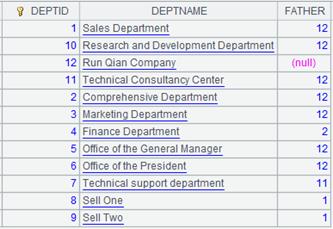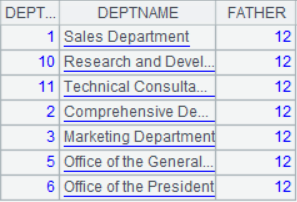A. select()
Description:
Return members of a sequence which satisfy a condition.
Syntax:
|
A.select(x) |
|
|
A.select(x1:y1, x2:y2, ......xi:yi) |
The simplified syntax of "&&" for a multiple-condition query, which is equal to A.select(x1== y1 && x2== y2 &&...... xi==yi) |
Note:
The function computes expression x against each member of the sequence A, and returns a new sequence composed of those members which make x return true. When there are no parameters, it returns all the members. Note that if the name of a to-be-referenced column of the sequence is the same as a cell name, the sequence name should be attached before the column name in the expression.
Parameter:
|
A |
A sequence |
|
x |
A Boolean expression, which can be null |
|
xi:yi |
xi is an expression, and yi is a comparing value |
Option:
|
@1 |
Return the first member that fulfills the condition |
|
@z |
Search the members from back to front |
|
@b |
Use binary search, which requires that A is an ascendingly ordered sequence and that parameters are separated by colon or they are expressions returning numeric values; the eligible members are found when result of expressions are 0 |
|
@m |
Use parallel algorithm to handle data-intensive or computation-intensive tasks; no definite order for the records in the result set; it can’t be used with @1bz options |
|
@t |
Return an empty table sequence with data structure if the grouping and aggregate operation over the sequence returns null |
|
@c |
Enable getting the eligible member(s) from left to right beginning from the first member until the first ineligible member appears |
|
@r |
Enable searching for the first eligible members from left to right and getting all members after it (inclusive) until the last one |
|
@v |
Return result as a pure table sequence when sequence A is a pure table sequence; return a pure sequence when this option is absent |
Return value:
A sequence or a table sequence
Example:
|
|
A |
|
|
1 |
[2,5,4,3,2,1,4,1,3] |
|
|
2 |
=A1.select(~>3) |
[5,4,4]. |
|
3 |
=A1.select@1(~>3) |
5; return the first eligible member. |
|
4 |
=demo.query("select EID,NAME,GENDER,DEPT,SALARY from EMPLOYEE order by EID") |
|
|
5 |
=A4.select(GENDER:"F",SALARY:7000) |
Multi-condition query.
|
.
Specify search direction:
|
|
A |
|
|
1 |
[2,5,4,3,2,1,4,1,3] |
|
|
2 |
=A1.select(~>3) |
[5,4,4]. |
|
3 |
=A1.select@z(~>3) |
[4,4,5]; search backwards. |
|
4 |
[8,10,3,5,7,9,11,13,7] |
|
|
5 |
=A4.select@c(~>7) |
Return [8,10]; search from the first member until the first ineligible member appears. |
|
6 |
=A4.select@zc(~>6) |
Return [7,13,11,9,7]; search backwards until the first ineligible member appears. |
|
7 |
=A4.select@r(~>10) |
Return [11,13,7]; Search for the first eligible member from the first member in order and get all members after it (inclusive). |
High-efficiency search and filtering:
|
|
A |
|
|
1 |
=demo.query("select EID,NAME,GENDER,DEPT,BIRTHDAY from employee") |
|
|
2 |
=A1.select@m(GENDER=="F") |
@m option enables parallel computation when there is a large volume of data to increase performance. |
|
3 |
=A1.sort(EID) |
Sort A1 by EID in the ascending order. |
|
4 |
=A3.select@b(EID<10) |
As A3 is an ascending sequence, here we use binary search to perform the query, for which parameter x should be a numeric expression. |
When a column name and a cell name are same:
|
|
A |
|
|
1 |
=to(3).new(~:ID,~*~:A1) |
|
|
2 |
=A1.select(A1.A1==4) |
As the column name and the cell name are same, the column name should be suffixed by sequence name when it is referenced in an expression.
|
Return a pure table sequence:
|
|
A |
|
|
1 |
=demo.query("select EID,NAME,GENDER,DEPT,BIRTHDAY from employee").keys(EID) |
|
|
2 |
=A1.i() |
Convert table sequence A1 to a pure table sequence. |
|
3 |
=A2.select(GENDER=="M") |
Return a pure sequence. |
|
4 |
=A2.select@v(GENDER=="F") |
@v option enables returning a pure table sequence. |
Related function:
Description:
Return members of a table sequence which satisfy a condition.
Syntax:
T.select@i(x)
Note:
The function computes expression x against each member of table sequence T, and returns a new table sequence composed of those members which make x return true
T is a table sequence for which an index is already created. T.select@i() will reuse the table sequence’s index and order of records in the result set will probably be disrupted.
The function returns all members when parameter x is absent.
Parameter:
|
T |
A table sequence for which an index is already created |
|
x |
Filtering expression; can be null |
Return value:
A table sequence
Example:
|
|
A |
|
|
1 |
=demo.query("select * from DEPT").keys@i(DEPTID) |
Return a table sequence whose key is DEPTID and create the hash index for it.
|
|
2 |
=A1.select@i(FATHER==12) |
Reuse the index created in A1 and return the record where FATHER is 12 in A1’s table sequence.
|




